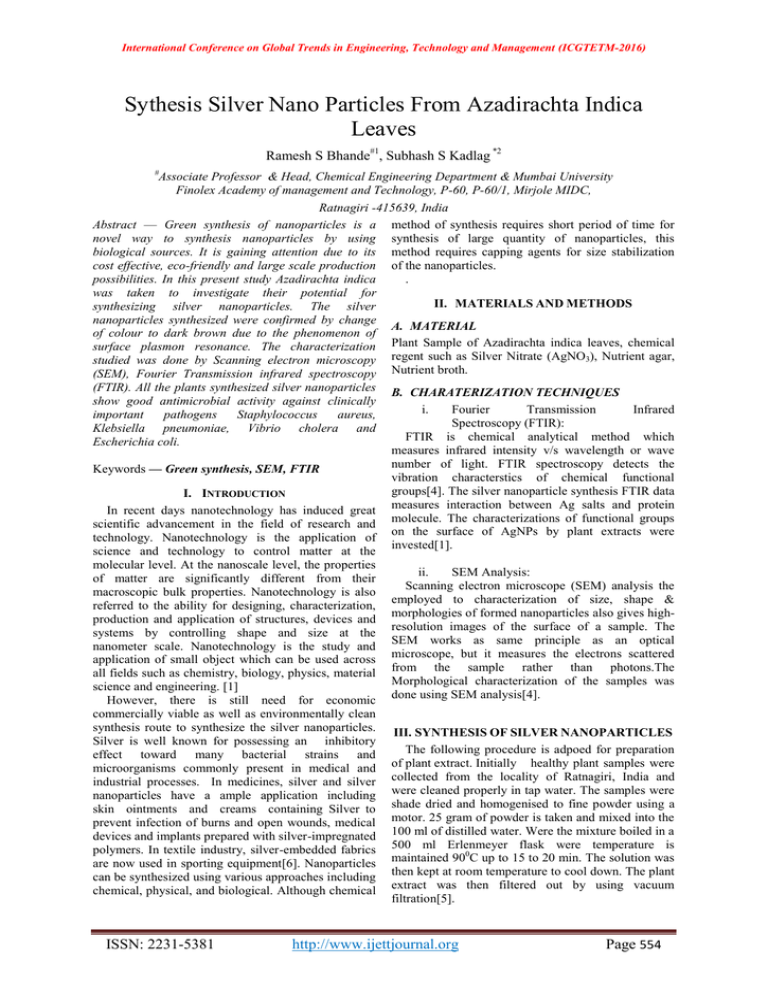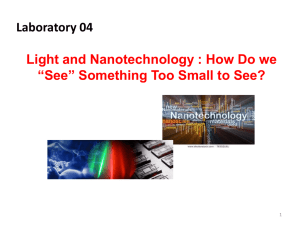Sythesis Silver Nano Particles From Azadirachta Indica Leaves Ramesh S Bhande
advertisement

International Conference on Global Trends in Engineering, Technology and Management (ICGTETM-2016) Sythesis Silver Nano Particles From Azadirachta Indica Leaves Ramesh S Bhande#1, Subhash S Kadlag *2 # Associate Professor & Head, Chemical Engineering Department & Mumbai University Finolex Academy of management and Technology, P-60, P-60/1, Mirjole MIDC, Ratnagiri -415639, India Abstract — Green synthesis of nanoparticles is a method of synthesis requires short period of time for novel way to synthesis nanoparticles by using synthesis of large quantity of nanoparticles, this biological sources. It is gaining attention due to its method requires capping agents for size stabilization cost effective, eco-friendly and large scale production of the nanoparticles. possibilities. In this present study Azadirachta indica . was taken to investigate their potential for II. MATERIALS AND METHODS synthesizing silver nanoparticles. The silver nanoparticles synthesized were confirmed by change A. MATERIAL of colour to dark brown due to the phenomenon of surface plasmon resonance. The characterization Plant Sample of Azadirachta indica leaves, chemical studied was done by Scanning electron microscopy regent such as Silver Nitrate (AgNO3), Nutrient agar, (SEM), Fourier Transmission infrared spectroscopy Nutrient broth. (FTIR). All the plants synthesized silver nanoparticles B. CHARATERIZATION TECHNIQUES show good antimicrobial activity against clinically i. Fourier Transmission Infrared important pathogens Staphylococcus aureus, Spectroscopy (FTIR): Klebsiella pneumoniae, Vibrio cholera and FTIR is chemical analytical method which Escherichia coli. measures infrared intensity v/s wavelength or wave number of light. FTIR spectroscopy detects the Keywords — Green synthesis, SEM, FTIR vibration characterstics of chemical functional groups[4]. The silver nanoparticle synthesis FTIR data I. INTRODUCTION In recent days nanotechnology has induced great measures interaction between Ag salts and protein scientific advancement in the field of research and molecule. The characterizations of functional groups on the surface of AgNPs by plant extracts were technology. Nanotechnology is the application of invested[1]. science and technology to control matter at the molecular level. At the nanoscale level, the properties ii. SEM Analysis: of matter are significantly different from their Scanning electron microscope (SEM) analysis the macroscopic bulk properties. Nanotechnology is also employed to characterization of size, shape & referred to the ability for designing, characterization, morphologies of formed nanoparticles also gives highproduction and application of structures, devices and resolution images of the surface of a sample. The systems by controlling shape and size at the SEM works as same principle as an optical nanometer scale. Nanotechnology is the study and application of small object which can be used across microscope, but it measures the electrons scattered all fields such as chemistry, biology, physics, material from the sample rather than photons.The Morphological characterization of the samples was science and engineering. [1] done using SEM analysis[4]. However, there is still need for economic commercially viable as well as environmentally clean synthesis route to synthesize the silver nanoparticles. III. SYNTHESIS OF SILVER NANOPARTICLES Silver is well known for possessing an inhibitory The following procedure is adpoed for preparation effect toward many bacterial strains and of plant extract. Initially healthy plant samples were microorganisms commonly present in medical and collected from the locality of Ratnagiri, India and industrial processes. In medicines, silver and silver were cleaned properly in tap water. The samples were nanoparticles have a ample application including shade dried and homogenised to fine powder using a skin ointments and creams containing Silver to motor. 25 gram of powder is taken and mixed into the prevent infection of burns and open wounds, medical 100 ml of distilled water. Were the mixture boiled in a devices and implants prepared with silver-impregnated 500 ml Erlenmeyer flask were temperature is polymers. In textile industry, silver-embedded fabrics 0 maintained 90 C up to 15 to 20 min. The solution was are now used in sporting equipment[6]. Nanoparticles then kept at room temperature to cool down. The plant can be synthesized using various approaches including extract was then filtered out by using vacuum chemical, physical, and biological. Although chemical filtration[5]. ISSN: 2231-5381 http://www.ijettjournal.org Page 554 International Conference on Global Trends in Engineering, Technology and Management (ICGTETM-2016) Plant extract was incubated in dark for 24 hours at room temparature. After 24 hours, 10 ml plant extract pipette out and take into the 500 ml Erlenmeyer flask. Take 0.1 N silver nitrate solutions in burette and added to the 10 ml of plant extract and stirred continuously. Change in the colour of the solution from pale yellow to dark brown, stop the addition of silver nitrate solution[4]. IV. RESULTS AND DISCUSSIONS A. FORMATION OF SILVER NANOPARTICLES Reduction of silver ions into silver nanoparticles during exposure to plant extracts was observed as a result of the colour change from pale yellow to dark brown. The formation of silver nanoparticles was preliminary confirmed by the colour changes from pale yellow to dark brown. Development of dark brown colour is due to the Surface Plasmon Resonance phenomenon property of silver nanoparticles. The metal nanoparticles have free electrons, which give observed around nm in case of Azadirachta indica[2]. Fig.2 FTIR Spectra of Azadirachta Indica Leaves C. SEM ANALYSIS SEM provided further insight into the morphology and size details of the silver nanoparticles. Figure 3 shows that SEM images at 500 nanometer scale. The micrographs of nanoparticles obtained in the filtrate showed that silver nanoparticles are spherical shaped well distributed without aggregation in solution with an average size of 35-65 nm. Azadirachta indica procumbens and aeglemarmelos extracts formed approximately spherical, triangular and cuboidal silver nanoparticles respectively[4]. These may be due to availability of different quantity and nature of capping agents present in different leaf extract. Fig. 1 Synthesis of Nanoparticles B. FTIR ANALYSIS FTIR spectrum clearly illustrates the bio fabrication of silver nanoparticles mediated by the plant extracts. Figure 2 shows the FTIR spectrum of azadirachta indica mediaited synthesised silver nano particles, the silver nitrate salt and dried azadirachta indica plant extract, in AgNO3 peaks were observed at 3692cm-1,which is associated OH stretching which having functional group alcohol, phenol. Azadirachta indica plant extracts peak were observed at 1699.94 cm-1, 1560.13 cm-1, 1095.37 cm-1, 697.141 cm-1, 563.112 cm-1, 523.57 cm-1, 504.29cm-1 which are associated C=O stretch, CH stretch, C–N stretch, C– Brstretch respectively. Azadirachta indica plant extracts peak were observed at 1699.94 cm-1, 1560.13 cm-1, 1095.37 cm-1, 697.141 cm-1having functional group Hydrogen bonded alcohols and phenols α, β unsaturated aldehyde and phenols, aliphatic amines, alkyl halides respectively. 563.112 cm-1, 523.57 cm-1, 504.27 cm-1 synthesized silver nanoparticles were observed surrounded by proteins and metabolites such as tarpenoids having functional group as above[1]. ISSN: 2231-5381 Fig.3 SEM Image of Silver Nanoparticles V. CONCLUSIONS Biological synthesis of nanoparticles has upsurge in the field of nanobiotechnology to create novel material that are eco-friendly cost effective stable nanoparticles with great importance for a wider application in the area of electronics, medicines and agriculture. In these current work nanoparticles were synthesized biologically using the azadirachta indica leaves extract. These method is purely as per green chemistry as well as completely toxic free chemical synthesis method in http://www.ijettjournal.org Page 555 International Conference on Global Trends in Engineering, Technology and Management (ICGTETM-2016) this respect nature has provide exciting possibilities of utilizing biological system for this purpose. The SEM studies were helpful at deciphering their morphology and distribution. FTIR studies confirmed the bio fabrication of the silver nanoparticles by the action of different photochemical with its different functional groups present in the extract solution. [4] [5] REFERENCES [1] [2] [3] Frank j Owens. Charles P. Poole, Introduction to Nanotechnology, WILEY-INDIA (Ed.), 2010. Abuye C, OmwegaAM, JK Imungi, Familial Tendency and Dietary Association of Goitre in Gamo-Gofa, Ethiopia. East African Medical Journal 76:447-451, (1999). Ahmad A, Mukherjee P, Mandal D, Senapati S, Khan MI, Kumar R, Sastry M, (2003). ―Extracellular biosynthesis of ISSN: 2231-5381 [6] silver nanoparticles using the fungus Fusariumoxysporum composite metal particles, and the atom to metal‖. Colloids and Surfaces B: Biointerfaces 28: 313-318. Ahmad A, Senapati S, Khan MI, Kumar R, Ramani R, Srinivas V, Sastry M, (2003). ―Intracellular Synthesis of Gold Nanoparticles by a Novel Alkalotolerant Actinomycete‖, Rhodococcus species‖. Nanotechnology 14:824–828. Ahmad N, Sharma S, Singh V. N., Shamsi S. F., Fatma A, Mehta B. R, ―Biosynthesis of Silver Nanoparticles from Desmodium Triflorum : A novel approach towards weed utilization‖. Biotechnology Research International, Vol. 2011 (2011). Akhtar AH, Ahmad KU (1995). ―Anti-ulcerogenic evaluation of the methanolic extracts of some indigenous medicinal plants of Pakistan in aspirin-ulcerated rats‖. Journal of Ethnopharmacology,vol. 46:1-6. http://www.ijettjournal.org Page 556







